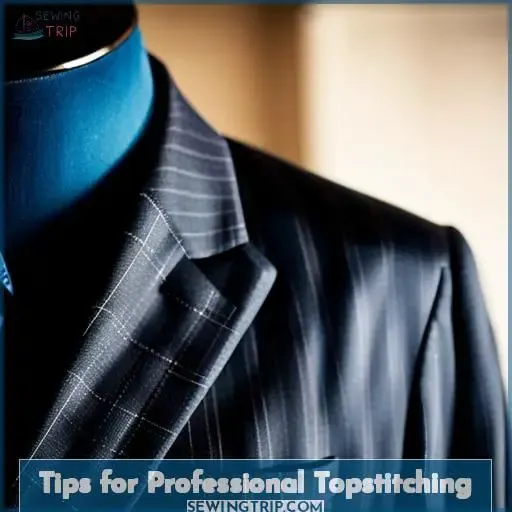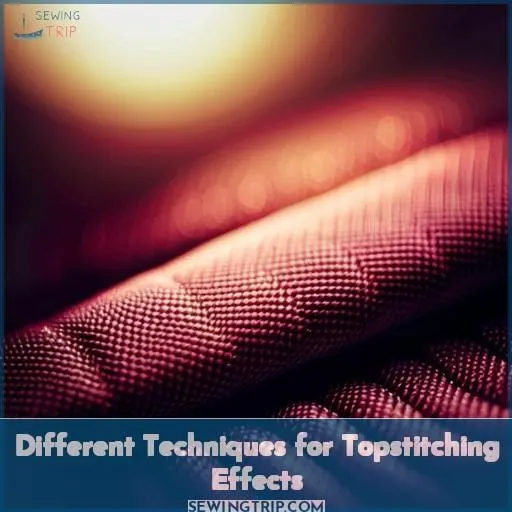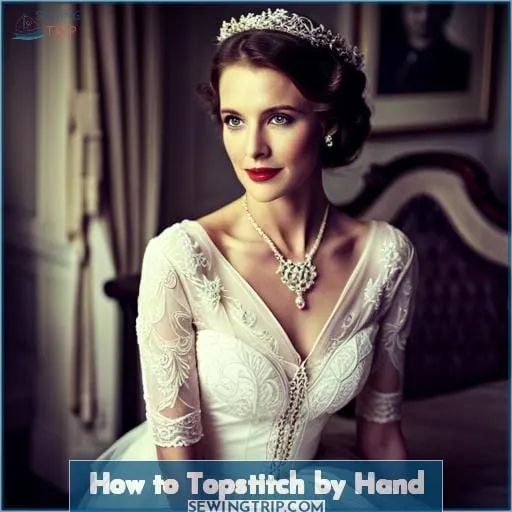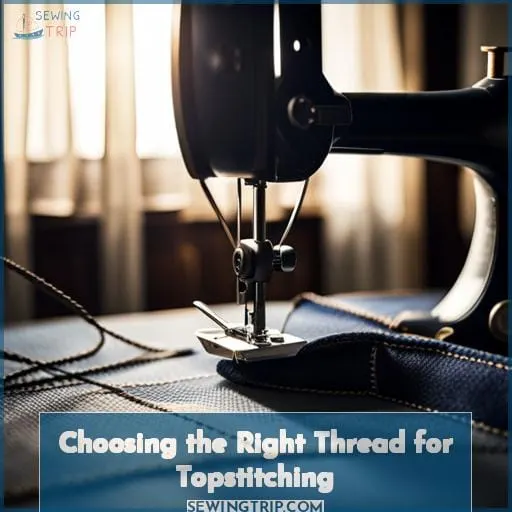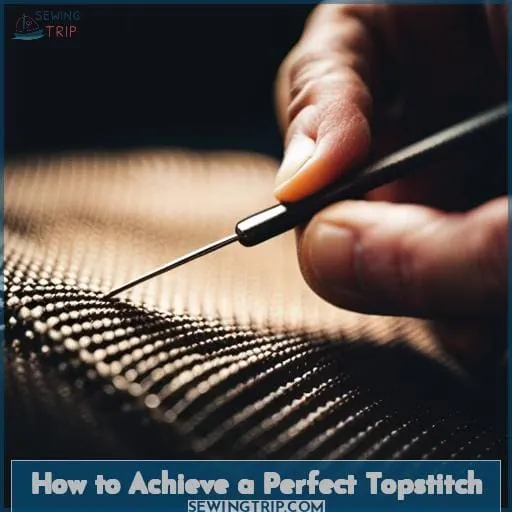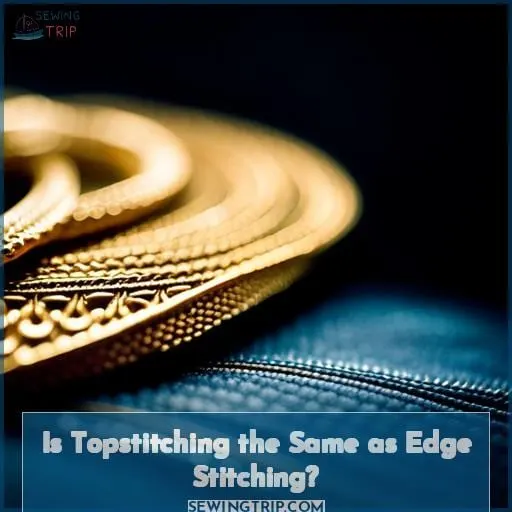This site is supported by our readers. We may earn a commission, at no cost to you, if you purchase through links.
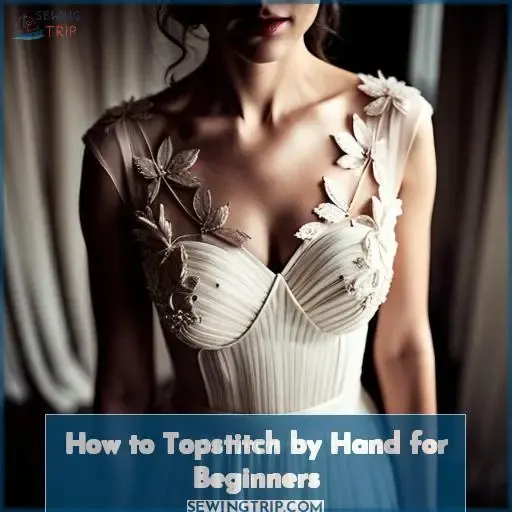 You’ve got this. Carefully thread your needle with a contrasting topstitch thread and tie a knot at the end. Bring the needle up through the fabric from the wrong side about 1/4 from the edge. Then gently pull the thread until the knot catches. Take small backstitches, keeping your tension firm but not too tight.
You’ve got this. Carefully thread your needle with a contrasting topstitch thread and tie a knot at the end. Bring the needle up through the fabric from the wrong side about 1/4 from the edge. Then gently pull the thread until the knot catches. Take small backstitches, keeping your tension firm but not too tight.
Stay focused, moving at a steady pace. Take pride in this handiwork. With practice, you’ll be creating crisp lines and elegant embellishments in no time. Topstitching takes patience, but the results are so rewarding. Your creation will have a refined, bespoke finish.
Now keep going, you’ve got this! With each stitch, you’re building your skills and confidence.
Table Of Contents
- Key Takeaways
- What is Topstitching and Why Do It?
- Tips for Professional Topstitching
- Different Techniques for Topstitching Effects
- How to Topstitch by Hand
- Where is Topstitching Used on Clothing?
- Choosing the Right Thread for Topstitching
- How to Achieve a Perfect Topstitch
- Is Topstitching the Same as Edge Stitching?
- Frequently Asked Questions (FAQs)
- Conclusion
Key Takeaways
- Thread the needle with contrasting topstitch thread and knot the end.
- Practice for crisp lines and elegant embellishments.
- Master the art of controlling each stitch; patience is required.
- Experiment with thicker thread and needles for multiple layers.
What is Topstitching and Why Do It?
When you’re hand-sewing, topstitching by hand will add that homemade touch your heart will crave like Grandma’s apple pie.
Decorative topstitching seams by hand for special occasions will give your project colorful, handcrafted effects.
Saddle stitching with hand-guided, visible decorative stitches will make your creations look special, not mass-produced.
Hand topstitching is all about taking the time to decorate with patience and care, making each stitch perfect.
Feel the thread glide through the fabric as you create your unique design.
Let your imagination wander, combining colors and stitches, enhancing the beauty.
Discover liberation in the hand sewing process, absorbing yourself in each stitch.
Hand-stitching satisfies that craving for intricate, decorative details with a power no machine can match.
Topstitching by hand grants the ultimate mastery, controlling each prick completely.
So grab your threaded needle and feel the fabric, preparing to topstitch creatively, mindfully, and beautifully.
Tips for Professional Topstitching
As an expert seamstress seeking intricate detail, master topstitching by hand with these tricks for achieving professional results. Keep your focus on the fabric’s surface as you stitch and monitor tension, guiding the project slowly without stretching; your eyes and hands working in tandem will yield straight lines along the right side.
Learn to Sew Straight
You’ll achieve even topstitching by hand if you keep your fabric from stretching as you guide it steadily along. With the right fabric technique, thread selection, and tension settings, your stitch appearance will reflect mastery of straight line, hand-stitched topstitch and decorative stitching using manual sewing methods.
Use Your Eyes and Hands Effectively
Steady your hands like a surgeon and guide the fabric gently with your eyes as you topstitch. Focusing too intently on the needle risks stretching the fabric, so rely on your hands and peripheral vision to sew straight, even stitches.
- Keep finger dexterity to not skip a beat.
- Hands strengthen seams through finesse.
- Stitching is Spanish work, admire the final beauty.
- Sewing practice develops fabric edge topstitch.
Prevent Fabric Stretching
Don’t let the fabric get stretched out as you’re stitching by hand. Keep it taut. Pin it before topstitching, do a stretch test on the fabric, and keep it firmly held down. Weigh it or use stabilizer. With practice, your hand-stitched topstitching and decorative stitching methods will have finesse.
Topstitch on the Right Side of the Fabric
As a seamstress, you delicately begin topstitching like a mother bird weaving her nest when starting each new garment, gently guiding the needle through the fabric’s right side.
- Use a contrasting thread color.
- Lengthen the stitch length.
- Adjust the tension for smooth stitches.
With practice, your hand-sewn topstitching will showcase your sewing craftsmanship.
Maintain Consistent Speed
You’re closer to consistent stitches when your hand glides smoothly along. Keep your posture upright and the lighting bright. Calibrate your speed with practice strokes. Let your hands grasp the rhythmic motion.
Different Techniques for Topstitching Effects
You can create unique topstitching effects by playing with different stitches, threads, and stitch lengths.
- Zigzag mirror image topstitching
- Wavy line topstitching
- Colorblocked topstitching
- Complex pattern topstitching
- Creative stitch placement
Embellish your garments with decorative stitching methods like hand-stitched topstitching or sewing embellishments to showcase your stitching finesse. Reinforce fabric edges and add flair with techniques like zigzag mirror image, wavy lines, colorblocking, and complex patterns.
Get creative with stitch placement, alternating long and short stitches, and combining machine and hand techniques. With practice, you’ll gain confidence in decorative stitching and edge reinforcement.
How to Topstitch by Hand
When hand topstitching, take your time for the best results as it requires great patience to get the perfect stitching effect.
Select a thicker, decorative thread and needle to prevent breakage when pulling through multiple fabric layers.
Gauge stitch length and spacing ahead of time for consistency. Mark with a washable pen if needed.
Prevent fabric from shifting using clips or pins along the stitching line.
Begin stitching on the inside of the garment, knotting thread ends securely. Insert the needle from the wrong side to the right side.
Use a straight stitch or backstitch, keeping your motions smooth and steady. Varying spacing creates an organic, handmade style.
Try different decorative stitching methods like running stitch or stem stitch for embellishing effects.
Your hand-stitched topstitch will exhibit finesse and artistry with practice. Manual sewing methods allow creative freedom.
Secure neat, sturdy stitch ends and remove markings to complete the process. Stand back and admire your handiwork!
Where is Topstitching Used on Clothing?
Topstitching by hand can be used on clothing details like collars, cuffs, pockets, and plackets to reinforce structure and enhance the appearance. Adding intentional highlights and polished accoutrements with hand-stitched topstitching allows for garment personalization and fabric manipulation.
With needlework mastery and sewing precision, the stitching finesse of a hand-topstitched detail provides an outlet for enlivening details and sewing aesthetics.
Hand Topstitching Highlights:
- Collars: Peter Pan, shirt, dress
- Cuffs: Shirt, jacket
- Pockets: Jeans, jacket
- Plackets: Shirt, dress
Focused hand-stitched topstitching transforms a garment, providing an empowering way to elevate your style through mastery of intricate sewing techniques.
Choosing the Right Thread for Topstitching
Gosh, selecting the perfect thread for hand topstitching can really make or break your project. I’d suggest starting with a thicker, high-quality thread like a polyester or cotton-covered polyester in a hue that complements your fabric.
It’ll not only hold up better to the demands of hand-stitching but also add beautiful dimension to your stitches.
Here are my top 5 thread tips for hand topstitching:
- Match thread weight to fabric weight – a heavier thread resists fraying.
- Choose tones that complement the base fabric – add a pop of color!
- Consider sheen effects like matte or lustrous threads.
- Mix up textures like twisted threads for visual interest.
- Explore decorative options like metallic for added flair.
With some testing and the right thread, your hand topstitching will elevate your project with flair and sophistication.
How to Achieve a Perfect Topstitch
You’ll create precise stitches by guiding the fabric smoothly under the needle and keeping your stitches evenly spaced and straight.
Ensure proper tension by threading the needle firmly but not tightly. Too loose and your stitches will snag; too tight and the thread will tear.
Use a straight stitch, taking care that each stitch is the same size. Keep your eye on the stitching line, not the needle, for straighter seams.
Mark measured intervals on the fabric with a disappearing ink pen before stitching to space stitches evenly.
With practice and care, your hand-stitched topstitching will showcase your mastery of garment embellishment.
Is Topstitching the Same as Edge Stitching?
Edge stitching is a type of topstitching that reinforces edges and provides a polished look.
| Edge Stitching | Topstitching |
|---|---|
| Decorative and functional | Mostly decorative |
| Done on garment edges and hems | Anywhere on the exterior side |
| Uses a straight stitch | Variety of stitch types |
| Reinforces seams | Primarily aesthetic |
| Requires tension adjustment | Requires tension adjustment |
With edge stitching, you carefully guide the fabric under the presser foot to sew straight and even lines. Adjusting the thread tension prevents puckering on the right side. First, mark stitch intervals with a water-soluble pen.
Then, edge stitch using a straight stitch and lock the ends. Maintain even gaps between stitches for consistent reinforcement. You can also play with decorative threads for flair. Both techniques add artistry and mastery to your hand sewing.
However, edge stitching specifically finishes edges, preventing fraying. It takes practice, patience, and precision.
Frequently Asked Questions (FAQs)
How long does it take to learn hand topstitching?
Learning hand topstitching takes time and practice. With diligent work, your skilled hands will master this intricate technique, elevating your craft. Patience and persistence transform rough stitches into artistry. Let go of perfection; savor the journey.
What are some common mistakes to avoid when hand topstitching?
My crafty friend, avoid dangling threads and uneven tensions. Practice patience, perfectionist! Your trembling hands betray imperfect patterns. Smile through frustration’s pricks and knots. Skill arises slowly, stitch by stitch.
What fabrics are best for beginners to practice hand topstitching?
When starting hand topstitching, choose medium-weight fabrics like cotton or linen. Their smooth, tight weaves won’t snag your thread as easily as loose knits. Take time practicing your saddle stitch—perfect tension elevates a hand-sewn look.
What tools and supplies are needed for hand topstitching beyond just a needle and thread?
You’ll need cloth scissors to trim threads, a thimble for pushing the needle, hand sewing needles in various sizes and types, embroidery hoops or frames to keep the fabric taut, marking chalk or disappearing ink for guidelines, and a tailor’s ham for curving stitching.
How can I make my hand topstitching more even and consistent?
Take your time and let your hands feel the fabric’s movement, like a potter molding clay. Keep the stitches small and even, moving at a steady pace. Breathe deeply as you sew, focusing only on the needle and thread.
Conclusion
As an experienced seamstress, I can assure you that learning to topstitch by hand takes time and patience, but it’s a valuable skill that allows you to add beautiful detail to your sewing projects.
With some practice stitches on scrap fabric and keeping a steady pace as you work, you’ll be amazed at the professional finish hand-topstitching can provide.
Don’t be discouraged if your stitches aren’t perfect right away – with a bit of diligence, your hand topstitching can rival that done by machine.
The extra effort is worth it for the satisfaction of knowing you personally crafted something unique.


